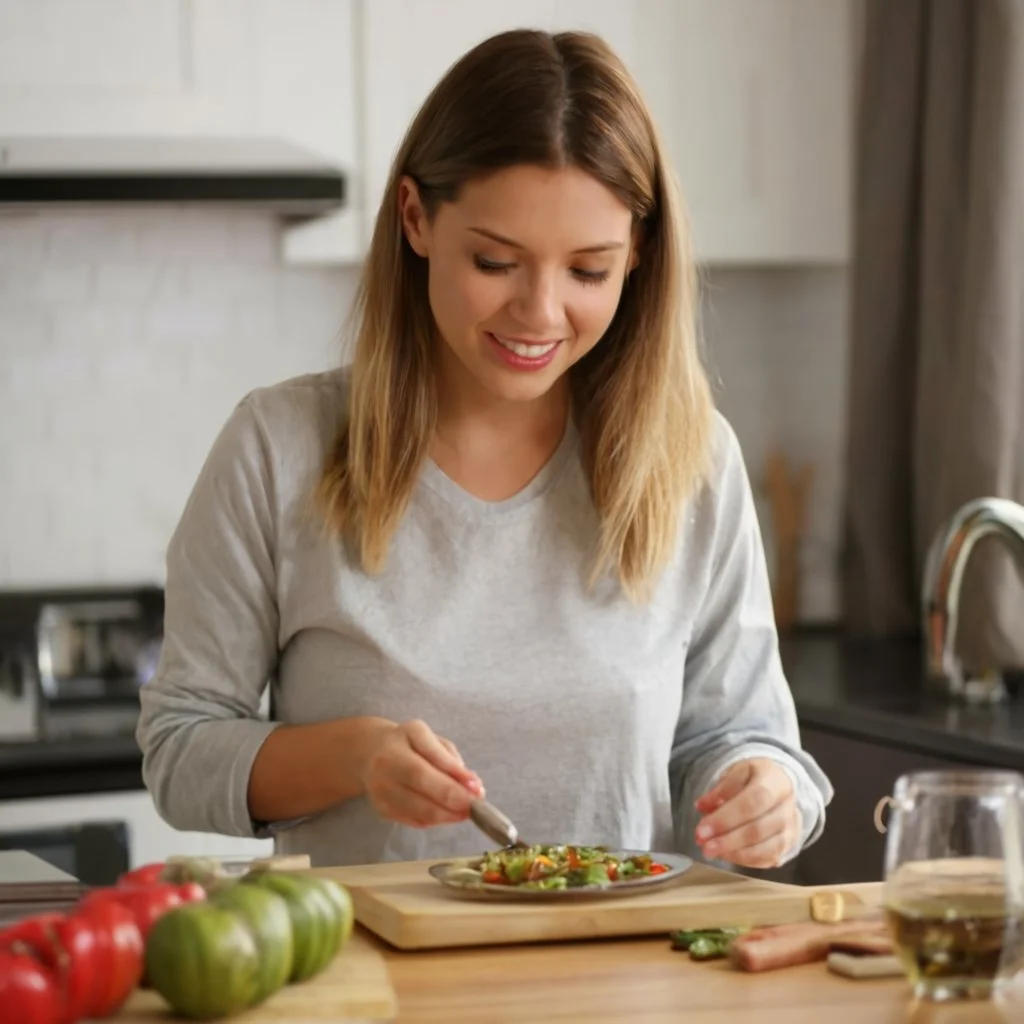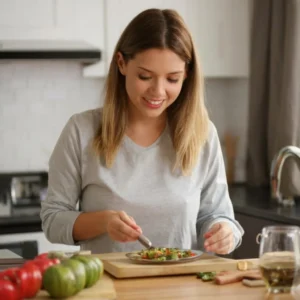Puffed Chicken, a delightful and versatile dish, has gained popularity for its rich flavors and exquisite texture. This article explores the various aspects of Puffed Chicken, from its history to modern culinary twists.
Puffed Chicken is not just a dish; it’s a culinary experience. It involves chicken encased in a light, flaky pastry, often known as puff pastry. This combination creates a delightful contrast between the tender, juicy chicken and the crisp, buttery pastry.
Types of Puffed Chicken Recipes
Puffed Chicken, a versatile and delightful dish, comes in several delicious variations. Each recipe offers a unique twist on how to encase tender chicken in a light, flaky pastry. Here are some popular types:
Classic Puff Pastry Chicken:
- This is the most straightforward version, where seasoned chicken breasts are wrapped in puff pastry sheets.
- The chicken is often marinated or seasoned with herbs for added flavor.
- It’s baked until the pastry puffs up and turns golden brown.
Chicken Wellington:
- A luxurious variant of Puffed Chicken, inspired by the famous Beef Wellington.
- It involves a chicken breast coated with a layer of duxelles (a finely chopped mixture of mushrooms, onions, and herbs) and then wrapped in puff pastry.
- This recipe is perfect for special occasions and is often served with a rich sauce. Learn more about this recipe from The Best Chicken Wellington.
Chicken in Puff Pastry Pockets:
- These are small, appetizer-sized portions of puff pastry filled with a chicken mixture.
- The filling can include cheese, vegetables, and various seasonings.
- These pockets are ideal for parties or as a starter.
Garlic Herb Chicken in Puff Pastry:
- In this recipe, chicken is slathered in a garlic and herb mixture, adding a burst of flavor.
- Spinach or other greens can be added for a nutritional boost.
- It combines the savory taste of garlic and herbs with the buttery texture of the pastry.
Cheesy Chicken Puff Pastry:
- This version includes cheese, such as Brie or cream cheese, along with the chicken in the puff pastry.
- The cheese melts during baking, creating a creamy texture that complements the crispy pastry.
Spiced Chicken Puff Pastry:
- For those who enjoy a bit of heat, adding spices like paprika, cayenne, or curry powder can elevate the dish.
- This variant often includes ingredients like bell peppers or onions for added flavor and texture.
BBQ Chicken Puff Pastry:
- A fusion recipe where the chicken is coated in BBQ sauce before being wrapped in pastry.
- This gives a sweet and tangy flavor, contrasting nicely with the pastry’s buttery taste.
Each of these recipes offers a unique way to enjoy Puffed Chicken, catering to different tastes and occasions. Whether you prefer something classic or with a twist, there’s a Puffed Chicken recipe for everyone.
Ingredients and Preparation
Creating Puffed Chicken involves a blend of simple yet flavorful ingredients and a series of preparation steps that lead to a delicious, visually appealing dish. Here’s a general guide on the ingredients and preparation method:
Ingredients
To prepare a basic Puffed Chicken dish, you will need:
- Chicken: 2-4 boneless, skinless chicken breasts or thighs.
- Puff Pastry: 1-2 sheets of ready-made puff pastry, thawed.
- Seasonings: Salt, pepper, and your choice of herbs (like thyme, rosemary, or parsley).
- Egg Wash: 1 egg beaten with a tablespoon of water.
- Optional Fillings: Depending on the recipe variation, ingredients like cheese, spinach, mushrooms, or garlic can be added.
Preparation
- Preheat the Oven: Start by preheating your oven to 400°F (200°C). This ensures that the pastry will puff and become golden brown.
- Prepare the Chicken:
- Season the chicken breasts with salt, pepper, and your chosen herbs.
- For added flavor, you can marinate the chicken in advance.
- Prepare the Puff Pastry:
- Roll out the puff pastry sheet on a lightly floured surface.
- If adding fillings like cheese or spinach, place them on the pastry before adding the chicken.
- Assemble:
- Place the seasoned chicken on the puff pastry.
- Fold the pastry over the chicken, trimming any excess. Seal the edges by pressing them with a fork.
- Apply Egg Wash:
- Brush the top of the pastry with the beaten egg. This gives the pastry a golden color and shine when baked.
- Bake:
- Place the prepared chicken on a baking sheet lined with parchment paper.
- Bake in the preheated oven for about 25-30 minutes, or until the pastry is puffed and golden brown.
- Rest and Serve:
- Let the Puffed Chicken rest for a few minutes after baking.
- Slice and serve while warm.
Tips for Perfect Puffed Chicken
- Pastry Thickness: Ensure the puff pastry isn’t rolled too thin; it needs to hold the weight of the chicken and fillings.
- Avoid Sogginess: Pat the chicken dry before seasoning to prevent the pastry from becoming soggy.
- Sealing Edges: Properly sealing the edges of the pastry helps to keep the fillings inside and gives a neat finish.
- Baking Temperature: A high oven temperature is crucial for achieving a well-puffed pastry.
The preparation involves seasoning the chicken, wrapping it in puff pastry, and baking it until the pastry is golden and puffed. For an innovative twist on the classic recipe, check out Garlic Herb Chicken in Puff Pastry.
Cooking Techniques
Mastering the cooking techniques for Puffed Chicken is essential to achieve the perfect balance of a crispy, golden pastry and a juicy, flavorful chicken filling. Here are some key techniques and tips to help you excel in preparing this delightful dish.
1. Preheating the Oven
- Consistent Temperature: Ensure your oven is preheated to the right temperature (usually around 400°F or 200°C) before baking. This high heat is crucial for the puff pastry to rise and become golden brown.
2. Preparing the Chicken
- Even Thickness: If using chicken breasts, pound them to an even thickness. This helps in even cooking.
- Seasoning: Season the chicken generously. This can include simple salt and pepper or a mix of herbs and spices, depending on the recipe.
3. Handling Puff Pastry
- Keep it Cold: Puff pastry should be kept cold until it’s time to use it. If it gets too warm, the butter in the pastry will melt, and it won’t puff properly.
- Rolling Out: Roll out the pastry on a lightly floured surface to prevent sticking. Don’t roll it too thin; it needs to support the weight of the chicken and fillings.
4. Assembling the Dish
- Layering: Place the chicken and any additional fillings (like cheese, spinach, or sautéed mushrooms) on the puff pastry. Ensure the fillings are not too wet to avoid a soggy pastry.
- Sealing: Seal the edges of the pastry firmly after folding it over the chicken. This keeps the filling secure and helps create a good puff.
5. Applying Egg Wash
- For a Golden Finish: Brush the pastry with an egg wash (a beaten egg mixed with a little water) before baking. This gives the pastry a beautiful golden color and shine.
6. Baking
- Correct Placement in Oven: Place the pastry on a baking sheet lined with parchment paper in the middle of the oven for even cooking.
- Baking Time: Bake until the pastry is puffed and golden brown, which usually takes about 25-30 minutes. Avoid opening the oven frequently, as the fluctuation in temperature can affect the puffing of the pastry.
7. Resting
- Let it Rest: Allow the Puffed Chicken to rest for a few minutes after taking it out of the oven. This helps in settling the juices and makes slicing easier.
8. Serving
- Slicing: Use a sharp knife to slice the Puffed Chicken. This ensures the pastry doesn’t get crushed and maintains its shape.
9. Troubleshooting
- If Pastry Doesn’t Puff: This could be due to the pastry being too warm before baking or the oven temperature being too low.
- Preventing Soggy Bottoms: If the bottom of the pastry is soggy, next time try preheating the baking sheet before placing the pastry on it.
By following these cooking techniques, you can create a Puffed Chicken dish that is both visually appealing and delicious. Remember, practice makes perfect, so don’t hesitate to experiment and refine your skills in making this delightful dish.
For those interested in expanding their chicken cooking techniques beyond puff pastry, mastering the art of smoking meat can be a fascinating journey. Discover more in our guide on Mastering Smoked Chicken Breast, complete with techniques and recipes.
Nutritional Value of Puffed Chicken
Puffed Chicken, while being a delightful culinary creation, also carries a specific nutritional profile. Understanding this can help in making informed dietary choices, especially for those who are health-conscious or have specific dietary needs. Here’s a breakdown of the nutritional aspects of Puffed Chicken:
1. Caloric Content
- The calorie count in Puffed Chicken primarily depends on the size of the chicken portion and the amount of puff pastry used.
- On average, a serving can range from 300 to 500 calories. Adding rich fillings like cheese or creamy sauces will increase the calorie count.
2. Protein
- Chicken is an excellent source of lean protein, which is vital for muscle building and repair.
- A single serving of Puffed Chicken can provide a significant portion of the daily recommended protein intake.
3. Carbohydrates
- The puff pastry is the primary source of carbohydrates in this dish.
- The type of pastry (whole wheat vs. regular) and the serving size will determine the carbohydrate content.
4. Fats
- Puff pastry, especially if made with butter, contributes to the fat content of the dish.
- The type of chicken used (breast vs. thigh) also affects the total fat content, with thighs being higher in fat compared to breasts.
5. Vitamins and Minerals
- Chicken is a good source of certain B vitamins, particularly niacin (B3) and vitamin B6, which are important for energy metabolism and brain health.
- Depending on the additional ingredients used (like vegetables or cheese), the dish can also provide other nutrients like calcium, iron, and vitamins A and C.
6. Dietary Fiber
- Traditional puff pastry has minimal dietary fiber. However, using a whole wheat puff pastry can increase the fiber content, which is beneficial for digestive health.
7. Sodium
- The sodium content can vary based on the seasonings and any added ingredients like cheese or processed fillings.
- It’s important to monitor the sodium level, especially for those on a low-sodium diet.
8. Cholesterol
- Both chicken and puff pastry contribute to the cholesterol content of the dish.
- Opting for leaner cuts of chicken and monitoring portion sizes can help manage cholesterol intake.
9. Considerations for Special Diets
- For those on a low-carb or ketogenic diet, traditional Puffed Chicken might be high in carbohydrates due to the pastry.
- Gluten-free versions can be made using gluten-free puff pastry.
Conclusion
While Puffed Chicken is a tasty and satisfying dish, it’s important to consider its nutritional value, especially if consumed regularly. Moderation is key, and for those with specific dietary goals or restrictions, adjustments can be made to the recipe to align with their needs. As always, enjoying a variety of foods and balancing indulgent dishes with healthier options is a good approach to a well-rounded diet.
Serving and Presentation Ideas
The way Puffed Chicken is served and presented can significantly enhance the dining experience. A dish that looks as good as it tastes is always more appealing. Here are some ideas for serving and presenting Puffed Chicken to impress your guests or make your family meals special.
1. Plating Techniques
- Slicing: Neatly slice the Puffed Chicken to showcase the layers of chicken and pastry. Arrange the slices on the plate in a fan shape or stack them slightly for a 3D effect.
- Sauce Drizzle: If serving with a sauce (like a creamy Dijon or a rich gravy), artistically drizzle it on the plate or around the chicken for a gourmet touch.
- Garnish: A sprig of fresh herbs like parsley or thyme adds a pop of color and freshness to the dish.
2. Accompaniments
- Vegetable Sides: Serve with steamed vegetables like green beans, carrots, or asparagus for a balanced meal. Roasted vegetables can also add a rustic charm.
- Salad: A light, crisp salad complements the richness of the Puffed Chicken. Consider a salad with a tangy vinaigrette to cut through the buttery pastry.
- Starches: For a more filling meal, pair with mashed potatoes, rice pilaf, or a simple pasta.
3. Presentation Styles
- Individual Plates: For formal dining, serve individual portions on each plate, carefully arranged with sides and garnishes.
- Family Style: Place the whole Puffed Chicken on a serving platter in the center of the table, allowing guests to help themselves. This works well for a casual, family-style meal.
- Appetizer Bites: If made in smaller sizes, Puffed Chicken can be served as appetizers. Arrange them on a platter with dipping sauces for a party-friendly presentation.
4. Creative Touches
- Edible Flowers: For a special occasion, edible flowers can add an elegant and colorful touch to the dish.
- Themed Presentation: Tailor the presentation to the occasion – use festive plating for holidays, or a romantic setup for date nights.
5. Serving Temperature
- Warm Serving: Puffed Chicken is best served warm to enjoy the crispiness of the pastry. However, ensure it’s not too hot, as it can make the pastry soggy.
6. Pairing with Beverages
- Wine Pairing: A light white wine or a sparkling variety can complement the dish well. For richer fillings, a medium-bodied red wine might be more appropriate.
- Non-Alcoholic Options: Sparkling water with a twist of lemon or herbal teas can also pair nicely with the dish.
Conclusion
Presentation and serving are as important as the cooking itself, especially for a dish like Puffed Chicken. These ideas can elevate the dish from a simple meal to a culinary experience, making it enjoyable both visually and taste-wise. Remember, the key is to balance the richness of the dish with the sides and to add personal creative touches to make it your own.
Variations and International Twists
Puffed Chicken can be adapted to various cuisines:
- Add spices like curry or paprika for an international twist.
- Experiment with different fillings like mushrooms, spinach, or cheese.
FAQs
What is puffed chicken feet?
Puffed chicken feet are a type of pet treat, particularly popular for dogs. They are made from chicken feet that have been cleaned, dehydrated, or air-dried, and sometimes puffed through a cooking process. This process removes moisture, resulting in a crunchy, chewy snack for dogs.
- Preparation: Puffed chicken feet are prepared by first cleaning the chicken feet thoroughly and then either dehydrating or baking them at a low temperature for several hours.
- Texture: The process of dehydration or baking makes them crunchy and less greasy compared to other types of dog chews.
- Nutrition: They are a natural source of glucosamine and chondroitin, which are beneficial for a dog’s joint health.
Are puffed chicken feet safe for dogs?
- Generally Safe: Puffed chicken feet are generally safe for dogs and are a popular choice for a natural chew treat.
- Choking Hazard Consideration: However, as with any treat, there’s a risk of choking, especially for aggressive chewers or smaller dogs. It’s important to supervise your dog while they’re enjoying this treat.
- Allergy and Digestibility: Some dogs might be allergic to chicken, and in rare cases, some might find chicken feet hard to digest.
How long does a dried chicken foot last?
- Long Shelf Life: Dried chicken feet can last a long time, typically several months, if stored properly in a cool, dry place. Keeping them in an airtight container can help preserve their freshness.
- Signs of Spoilage: If they start to smell off or show signs of mold, they should be discarded.
What age can dogs eat chicken feet?
- Age Consideration: Dogs can start eating chicken feet once they have transitioned to solid food and can safely chew and digest harder food items. This is usually around the age of 12 weeks or older.
- Puppy Consideration: For puppies, it’s important to ensure that the chicken feet are of an appropriate size to prevent choking hazards.
- Consultation with Vet: Always consult with a veterinarian before introducing any new treat or food item into your dog’s diet, especially for puppies or dogs with specific health conditions.
Conclusion
Puffed Chicken is a versatile and delightful dish that can be adapted to various tastes and occasions. Whether you’re hosting a dinner party or looking for a special family meal, Puffed Chicken is sure to impress.
If you’re intrigued by the versatility of chicken in puff pastry, you might also enjoy exploring another elegant chicken dish, the Chicken Rollatini, which is a true culinary delight.



Thank you for your sharing. I am worried that I lack creative ideas. It is your article that makes me full of hope. Thank you. But, I have a question, can you help me?